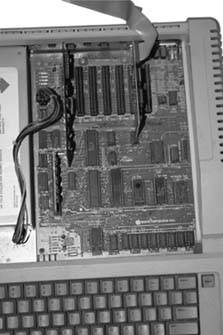Hack53.Run the Apple
![]()
![]()
Get your old system up and running again .
There are old Apple ][ systems, from the original Apple ][ to the last Apple IIgs ROM 3, lurking in attics, closets, basements, and the occasional store all over the world. I kept my old Franklin Ace 1000 (an Apple ][+ clone) in my parents' attic for a decade or so, and found the hardware worked just fine when I turned it on. I've since acquired an Apple //e and two IIgs computers, and an Apple IIe card for a Macintosh LC. There's lots of Apple ][ stuff out there, though Apple discontinued the IIgs in 1991, and the IIe emulator card in 1993. Searching on eBay today brings up 212 items for the string "Apple II". ("Apple ][ doesn't work well as an eBay search string, as the ][ seems to get ignored.)
|
Making an Apple ][ system work requires a few key ingredients : an Apple ][ (or compatible) of some kind, a disk drive that works with that computer (unless you have a model that supports tape cassettes and have a lot of patience), a monitor (a TV is fine), and some functioning floppy disks. Sadly, disks can demagnetize over time, and I discovered to my sorrow that many of my more than one hundred old disks no longer worked. The ingredients you need vary slightly by computer:
-
Apple ][, ][+, //e, Franklin Ace, or similar
-
All of these computers come as a box with 8 expansion slots and a video output. Unless you want to turn them on, type for a bit, and lose everything, you'll want to have a disk controller and a floppy drive (like the Disk II or one of its many clones ) or preferably two. The disk controller, which should be installed with the power off, traditionally goes in slot 6. Be very careful when you attach the disk drive connectors to the controller, as shifting the connection off by one line of pins can burn out your disk drive quickly. Figure 5-1 shows the proper alignment of the pins and the controller connection, and Figure 5-2 shows the card in the slot in an Apple IIe.
Figure 5-1. Connecting an Apple disk drive to the controller card

Figure 5-2. Installing the controller card


Be very, very careful when working inside the case of the Apple II series. While installing that disk drive, I gave myself a nice deep cut to my finger while removing a port cover on the back of the machine! It's a metal case, machined for function rather than safety.
-
Apple //c, //c+
-
These computers are all-in-one units, including a built-in floppy drive with safer connectors for additional floppy drives . The //c has the more traditional 5.25" drive, while the //c+ has the more recent 3.5" drive.
-
Apple IIgs
-
The IIgs does look a lot like an Apple IIe on the inside, with slots for expansion, but it's generally a very different computer, using an ADB keyboard like old Macintoshes and a disk drive connection like the //c series. To make a IIgs work, you'll need a disk drive or two as well as an ADB keyboard and cable and possibly a mouse.
-
Apple IIe Compatibility Card for Macintosh LC
-
Apple sold these largely to convert schools from their large installed base of Apple ][ systems to Macintoshes. The keyboard and 3.5" floppy drive come through the Macintosh, but you can connect external floppy drives (only the A9M0107 5.25" drive and the A2M2053 3.5" drive) to the system, and also use ProDOS partitions on the Mac's hard drive. Video for this system goes to the Macintosh monitor. For more on this option, which is great if you want to play retro Mac games as well as retro Apple ][ games , see http://www.mandrake.demon.co.uk/Apple/lc_card_faq.html or http://homepage.mac.com/vectronic/appleii/appleiiecard.html. It only works on a select group of Macs with the LC PDS slot and the ability to run in 24-bit addressing mode, however.
The composite video output on all of the regular Apple computers (which looks like an RCA audio plug), can go directly to the composite inputs on newer TVs or VCRs, or you can use an adapter to convert them to TV channel 3 or 4, and connect through the VHF or coaxial inputs on the television. The IIgs systems also have an RGB monitor connection, but be careful about which monitor you connect. It synchronizes fine with an AppleColor RGB monitor, but won't sync at all with my Macintosh monitors , despite using the same connectors.
|
Once you have the basic parts together, you can fire up the system with a floppy in the primary disk drive and see what you get. With luck you'll see something like Figure 5-3.
If you're working with older floppies, you may find that it takes a while before finding one that's willing to boot. You can order fresh system disks from http://store.syndicomm.com/, in DOS 3.3, ProDOS, or OS/GS varieties. Remember, disks that won't boot may still have useful information on them. Boot up from a different floppy and look around. "Become an Apple Guru" [Hack #56] explains a variety of things you can do now that you have the hardware up and running.
Figure 5-3. An Apple IIe, running with a recent vintage television

|
Simon St.Laurent
EAN: 2147483647
Pages: 150
- Chapter IV How Consumers Think About Interactive Aspects of Web Advertising
- Chapter V Consumer Complaint Behavior in the Online Environment
- Chapter IX Extrinsic Plus Intrinsic Human Factors Influencing the Web Usage
- Chapter XI User Satisfaction with Web Portals: An Empirical Study
- Chapter XIII Shopping Agent Web Sites: A Comparative Shopping Environment
